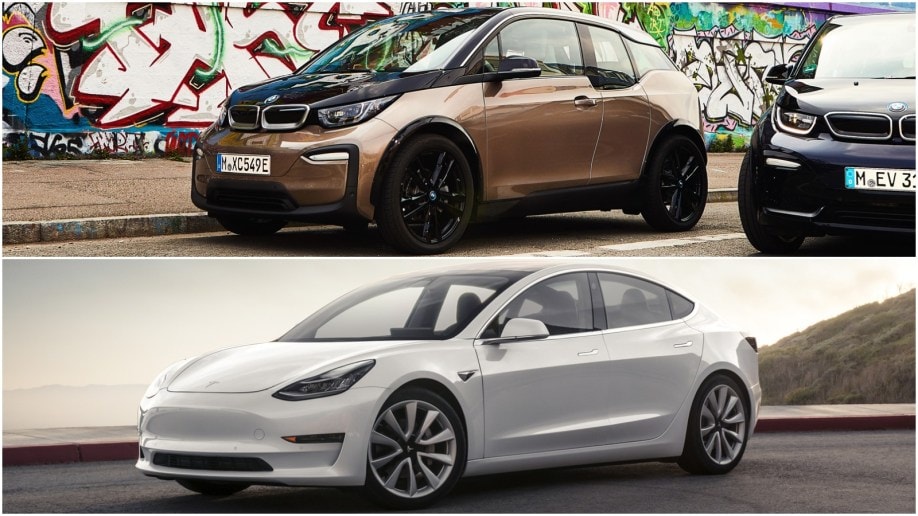With the hullabaloo over the Audi e-tron, Jaguar I-Pace, Mercedes-Benz EQC, and Porsche Taycan, it’s easy to forget that BMW has been selling an electric car since 2014.
Unlike anything BMW had offered before, except for perhaps the weird little Isetta from the 1950s, the quirky i3 blends industrial-chic design with lots of practicality in a package that’s perfect for image-conscious urban and suburban dwellers. However, despite power, performance, and range improvements over the years, several newcomers now outgun the BMW i3, especially the Tesla Model 3.
Last year, Tesla Model 3 was the best-selling compact luxury car in America. The BMW i3 never came anywhere close to that status. And that tells you everything you need to know.
However, that doesn’t mean the BMW i3 is without redeeming qualities. In this BMW i3 vs. Tesla Model 3 comparison article, we’ll explain why you might want the BMW anyway.
The best things about the BMW i3
The BMW i3 gives you something the Tesla Model 3 can’t: a range-extending 2-cylinder gasoline engine. And for people who worry about finding open charging stations when traveling long distances, this option makes all the difference in the world.
It costs $3,850, and it provides less than 50 extra miles of driving range, but this gas-fueled onboard generator means you’ll always make it home. And it also means you’ll still be able to use your BMW i3, even during power outages.
Another ace up the BMW’s air curtains is its hatchback configuration. Though trunk space is about the same as the Model 3 (15.1 cubic feet in the BMW vs. 15 cubes in the Tesla), if you fold the i3’s seats down you’ve got 36.9 cubic feet of space and a loading portal that accommodates bulky items.
The $445,445 BMW i3 is also eligible for the full $7,500 federal income tax credit, the Tesla Model 3’s credit has expired. Therefore, the BMW i3 effectively costs the same as the cheapest Model 3 which comes in at $37,990.
Other appealing BMW i3 characteristics include its free maintenance for three years or 36,000 miles, its extensive use of recycled and sustainable materials in its construction, and assembly in a BMW factory that is carbon-neutral. Oh, and it comes with Apple CarPlay and a Wi-Fi hotspot.
The best things about the Tesla Model 3
The base Tesla Model 3 offers a range of 250 miles, almost 100 more miles than the i3’s 153 miles. It also accelerates to 60 mph almost two full seconds faster than the BMW and recharges at a quicker rate if not in less time (depending on the type of charger).
In short, the Model 3 is the better electric car.
Plus, it has a sleek, stylish, and tailored look. The minimalist interior isn’t going to appeal to everyone. Still, the 15-inch control panel supports over-the-air updates so that the software will always be up to date. Tesla also provides 12-way power-adjustable front seats, wireless smartphone charging for two devices at the same time, and standard driving assistance and collision avoidance technologies.
Finally, if you’re really into the whole semi-autonomous car movement, you can outfit the Model 3 with Autopilot. Of course, this option adds $8,000 to the price. Just remember that a driver remains a requirement, so no napping, even if the Tesla gets a Top Safety Pick+ rating from the Insurance Institute for Highway Safety.
The Model 3 is also prepped for a variety of self-parking and summoning features, though recent news reports suggest that Summon isn’t as effective as owners expect.
BMW i3 vs. Tesla Model 3. Who wins?
In this contest, Tesla builds a better electric car. However, there is a place for the BMW i3, especially if you suffer from range anxiety, or you need to carry bulky cargo from time to time, or you just like its funky modernistic design.
Not everybody needs 250 miles or more of driving range. And not everybody wants to drive the same electric car that more than 145,000 people bought in 2018. As an alternative, the BMW i3 could prove compelling.









